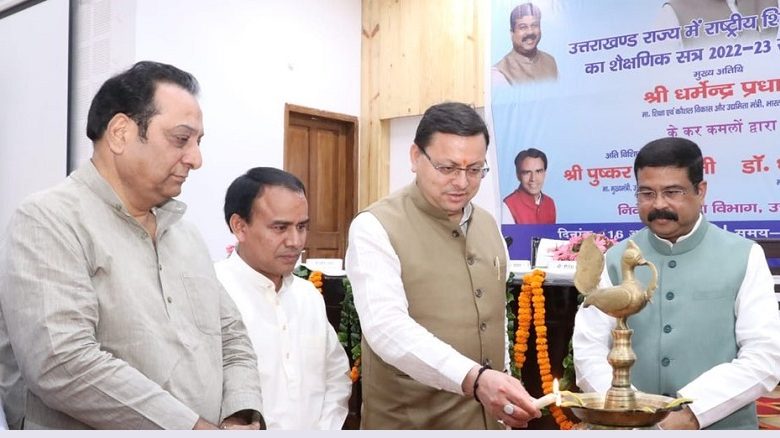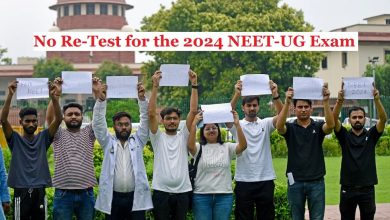New Education Policy Launched in Higher Education in Uttrakhand
According to the new educational strategy, children in Bal Vatikas will begin receiving official instruction at age three, and by the time they reach Class 1, they will be six years old.

Dehradun: On Sunday, Pushkar Singh Dhami, the chief minister of Uttarakhand, and Union Minister of Education Dharmendra Pradhan unveiled the National Education Policy 2020 for the academic year 2022–2023. Bal Vatikas were used to introduce the new education policy in basic school in Uttarakhand, the first state in the nation.
The first state in the nation to implement a new primary education strategy using Bal Vatikas was Uttarakhand.
He remarked that initiatives will need to be taken to guarantee that all kids enrol in Bal Vatikas.
According to Pradhan, the new education strategy has been developed with consideration for all facets of human existence.
In addition to schooling, the new strategy has focused on the skill and personality development of children as well as instilling moral values in them, he added.
According to the new educational strategy, children in Bal Vatikas will begin receiving official instruction at age three, and by the time they reach Class 1, they will be six years old.
”We need to start with a target of giving quality education to 40 lakh children in Uttarakhand from infancy to the age of 21-22 years under the new policy,” the Union Minister said.
Dhami said “effective steps” have been taken in a phased manner by the state higher education department for the implementation of the new education policy.
”The new national education policy prepared under the guidance of Prime Minister Narendra Modi will lay the foundation of a new, strong and self-reliant India,” Dhami said.
Salient Features of National Education Policy, 2020:
National Education Policy 2020 has been announced on 29.07.2020. The National Education Policy 2020 proposes various reforms in school education as well as higher education including technical education. A number of action points/activities for implementation in school education as well as higher education are mentioned in the National Education Policy 2020. Details of the salient features of NEP 2020 are as follows-
- Ensuring Universal Access at All Levels of schooling from pre-primary school to Grade 12;
- Ensuring quality early childhood care and education for all children between 3-6 years;
- New Curricular and Pedagogical Structure (5+3+3+4);
- No hard separations between arts and sciences, between curricular and extra-curricular activities, between vocational and academic streams;
- Establishing National Mission on Foundational Literacy and Numeracy;
- Emphasis on promoting multilingualism and Indian languages; The medium of instruction until at least Grade 5, but preferably till Grade 8 and beyond, will be the home language/mother tongue/local language/regional language.
- Assessment reforms – Board Exams on up to two occasions during any given school year, one main examination and one for improvement, if desired;
- Setting up of a new National Assessment Centre, PARAKH (Performance Assessment, Review, and Analysis of Knowledge for Holistic Development);
- Equitable and inclusive education – Special emphasis given on Socially and Economically Disadvantaged Groups (SEDGs);
- A separate Gender Inclusion fund and Special Education Zones for disadvantaged regions and groups;
- Robust and transparent processes for recruitment of teachers and merit based performance;
- Ensuring availability of all resources through school complexes and clusters;
13. Setting up of State School Standards Authority (SSSA);
14. Exposure of vocational education in school and higher education system;
- Increasing GER in higher education to 50%;
16. Holistic and Multidisciplinary Education with multiple entry/exit options;
- NTA to offer Common Entrance Exam for Admission to HEIs;
- Establishment of Academic Bank of Credit;
(xix) Setting up of Multidisciplinary Education and Research Universities (MERUs);
- Setting up of National Research Foundation (NRF);
21. ‘Light but Tight’ regulation;
- Single overarching umbrella body for promotion of higher education sector including teacher education and excluding medical and legal education- the Higher Education Commission of India (HECI)-with independent bodies for standard setting- the General Education Council; funding-Higher Education Grants Council (HEGC); accreditation- National Accreditation Council (NAC); and regulation- National Higher Education Regulatory Council (NHERC);
- Expansion of open and distance learning to increase Gross Enrolment Ratio (GER).
- Internationalization of Education
- Professional Education will be an integral part of the higher education system. Stand-alone technical universities, health science universities, legal and agricultural universities, or institutions in these or other fields, will aim to become multi-disciplinary institutions.
- Teacher Education – 4-year integrated stage-specific, subject- specific Bachelor of Education
- Establishing a National Mission for Mentoring.
- Creation of an autonomous body, the National Educational Technology Forum (NETF) to provide a platform for the free exchange of ideas on the use of technology to enhance learning, assessment, planning, administration. Appropriate integration of technology into all levels of education.
- Achieving 100% youth and adult literacy.
- Multiple mechanisms with checks and balances will combat and stop the commercialization of higher education.
- All education institutions will be held to similar standards of audit and disclosure as a ‘not for profit’ entity.
- The Centre and the States will work together to increase the public investment in Education sector to reach 6% of GDP at the earliest.
- Strengthening of the Central Advisory Board of Education to ensure coordination to bring overall focus on quality education.
NEP, 2020 aim to increase the GER to 100% in preschool to secondary level by 2030 whereas GER in Higher Education including vocational education from 26.3% (2018) to 50% by 2035.
Also Red: Amit Shah Releases Textbooks in Hindi for MBBS Students





